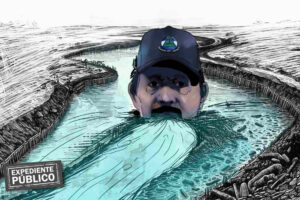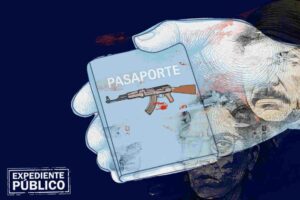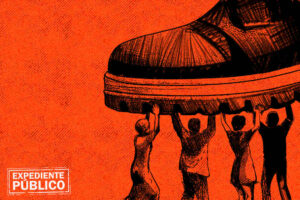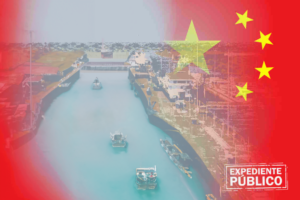*Interview with Expediente Público and Café con Voz: released political prisoner known as “La Loba Feroz,” or the “Fierce Wolf,” originally from the indigenous neighborhood of Monimbó located in Masaya, Nicaragua, tells the story of his imprisonment during which he suffered three years, ten months, and 20 days for supporting protests against the Nicaraguan regime.
**In prison, he witnessed the custodians of “La Modelo” prison torture political prisoners, including himself, reporting that “they wanted the prisoners to die of hunger.”
Expediente Público
Edward Enrique Lacayo Rodríguez turns 49 years old on March 12, and he will celebrate his birthday in freedom and outside of prison but in a foreign country. Lacayo Rodríguez, better known as “La Loba Feroz” or the “Fierce Wolf,” is one of the 222 political prisoners who were released and exiled from Nicaragua and sent to the United States (US) by the Daniel Ortega and Rosario Murillo regime last February 9. In the US, he received humanitarian parole.
He spent his previous birthdays as a prisoner of the Jorge Navarro Penitentiary System in Tipitapa, also known as “La Modelo,” where he served a 15-year prison sentence on charges of racketeering and illegal drug transportation.
On March 15, it would have been four years since he was captured in 2019 by masked civilians in El Ostional, a community located in the southeast of Nicaragua in the department of Rivas.
“In March, it will have been four years, and the truth is, I do not feel free yet. I do not, cannot feel free because although my body is physically here, my heart, mind, and spirit are still in Nicaragua,” said Lacayo Rodríguez in an interview with Expediente Público and Café con Voz.
Pursued by the regime in Nicaragua
“La Loba Feroz” was imprisoned by the regime for participating in the 2018 social protests. Since the day he was captured, his sister Karen Lacayo and his mother Estela Rodríguez began to live a nightmare as well, due to the constant siege that they suffered from the police in Masaya every time they demanded the freedom of “La Loba Feroz.”
Read: Expresos políticos desterrados de Nicaragua celebran la libertad en Estados Unidos
“I cannot say that I am free yet because I have sadly not been able to get my mother and sons out of the country. I will do so as soon as possible. It is not that I am fleeing, but, rather, they brought us here against our free will. I still feel like a prisoner because Nicaragua is one big prison,” said the former political prisoner.
He remembered that when he was five years old, he and his parents were exiled to Mexico City. “I was exiled, together with my father and mother, for five years in Mexico, and it pains me that this has happened again, that I have had to leave the country as if I have committed a crime. The US did not do this. God did it,” he said.
Subscribe to Expediente Público’s newsletter and receive more information
Tortured in prison
In prison, Lacayo Rodríguez was confined to a punishment cell, suffered psychological torture, and at one point, was not allowed to receive visits from his family.
“Many inmates supported me: they would send me food under the hidden door, but when the guards noticed, you should have seen what they did to those people. Their intention was for me to slowly starve to death,” said Lacayo Rodríguez.
In confinement, I also witnessed the torture to which the other political prisoners were subjected. “There were those who suffered a lot. A few days ago, Kevin Solís, an imprisoned university student, was tortured. The problem was remaining silent, not saying anything. They beat Kevin unjustly because he asked for something. They tortured him as if to say, ‘shut up. I am stronger than you,’” he pointed out.
Read: Monseñor Rolando Álvarez sentenciado por Daniel Ortega a 26 años de cárcel
The Mechanism for the Recognition of Political Prisoners in Nicaragua registered more than 245 political prisoners in the country as of January 2023. Among the political prisoners were their family members, who were jailed in the last few months as the regime’s way of repressing the population.
“Maybe the beatings, bruises, and lack of food, because they were trying to kill me through starvation, have passed; I could forget everything, but the suffering that my family experienced in there, the suffering that neighbors, friends, and strangers lived, and those prayers and cries have made that suffering hurt more,” said the released prisoner.
The regime’s atrocities
In prison, I remembered the pain that Nicaraguan families had experienced since 2018. “I relived all the atrocities that occurred in Monimbó, where people died at my side, every day,” Lacayo Rodríguez recounted.
When I was isolated in a cell, I thought of the thousands of citizens who fled into exile to escape the repression of the Ortega and Murillo regime.
“I will tell you something: my biggest torture was thinking about all those people, about how they were living. Sadly, differences still exist, and there are power struggles, which have made us susceptible to falling under this sort of control and permitted the tyranny to continue. This time, I hope that we have one thing in common: God, our heavenly father, who has liberated us from all of the poor conditions in which we find ourselves. God is with us,” said the former political prisoner.
Despite the regime having liberated 222 political prisoners in Nicaragua, there are 32 people who remain imprisoned, including ten who were captured before 2018, according to the Mechanism for the Recognition of Political Prisoners in Nicaragua.
“The suffering of all their family members is what has lasted longer: already eight and a half, nine, ten years. Of those first kidnappings, we have Commander Pantera, Marvin Vargas, and El Cachorro, the first of all the prisoners,” said “La Loba Feroz” to Expediente Público in a special issue with Café con Voz.
Monimbó, a symbol of resistance in Nicaragua
Monimbó turned into one of the main banners of the Sandinista Revolution in 1979. In 2018, it was one of the first cities where citizens protested the reform to social security announced by the regime, provoking discontent throughout Nicaragua.
Through barricades strategically located at different points throughout the city, Monimbó turned into a symbol of resistance.
Read: 109 desterrados políticos de Nicaragua necesitan apoyo en Estados Unidos
“I have so many things to say to Monimbó, that irreverent and rebellious heart. Because of history, we have unfortunately taken the place of our fathers, and history has repeated itself. I wore my father’s shoes, which were big and are still too big for me. What I hope is that my son, and please understand the metaphor, does not repeat the same story 40 years down the road and take my place. It is not Nicaragua’s time. Nicaragua has lived almost 100 years of tyranny,” said Lacayo Rodríguez.
“Monimbó will always be in my heart. I will always know that I fought for Monimbó, for Masaya, for Nicaragua, and I will continue to do so. God has given me life to be one more piece of this condition, which exists to get rid of Sandinismo completely,” he assured.





